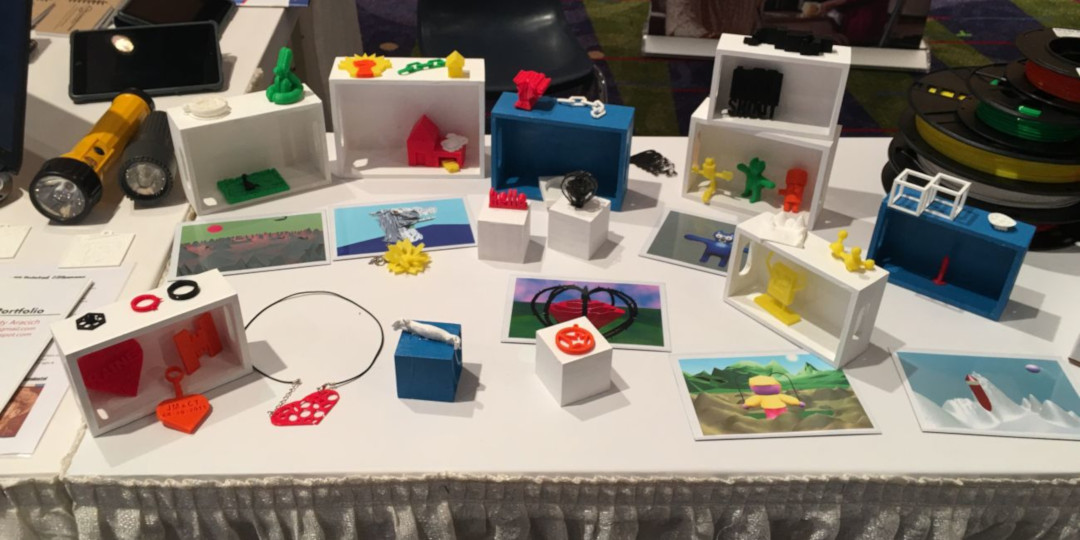After receiving a grant to cover the costs, Pioneer Wendy Aracich is working on putting together and implementing a mobile makerspace for her school. What makes this story extra special is that Wendy teaches virtually and the 4000 students of her school are spread across the state of Georgia.
A few years ago, my school won a 3D printer through a competition hosted by Thingiverse. What makes our situation a little unique is that I teach for a virtual school. Georgia Connections Academy is a public charter school that is open to students in grades K-12 who are residents of the state of Georgia. Our 4000 students have chosen virtual school instead of a traditional bricks and mortar school. They access their lessons virtually through a learning management system, interact with their teachers through live classrooms and over the phone, and move through their lessons at an individualized pace.
As a virtual teacher, I don’t teach in a traditional classroom, and I don’t typically see or interact with my students face-to-face. While I occasionally host in-person workshops, activities, and events, most of the time, I instruct them virtually. Despite this, I found myself wanting a 3D printer for my school. I had never used one before, but felt that it was something that would enhance our curriculum and give us something extra that we could offer to our students. I didn’t completely think about the logistics of it; I decided that if I won the printer, I would figure it out then. Well, sure enough, we won the printer and I had to come up with a plan for how to teach 3D printing to virtual students.
Virtual teaching — Wendy teaching a lesson on 3D Modeling in her virtual classroom.
I had been teaching a 3D modeling course (mostly using Blender) for a few years, so that seemed like a logical place to start. Not wanting to bite off more than I could chew, I began by offering the option for students in that course to 3D print one of their designs, which allowed me time to learn how to use the printer as they were developing their projects. The students loved it, and I eventually added 3D printing projects to all of my art courses. I noticed how much more engaged students were with these hands-on projects and how it gave them an opportunity to apply what they were learning while also developing stronger technology, design, and construction skills. By the end of that first year, I was officially in love with 3D printing.
3D printing virtually is not without its challenges. Getting files from students, figuring out how and when to print, and getting finished models to students were some of the problems I had to figure out that first year. Not everything I tried worked well, and there was often a lot of time lost between different iterations of a design. Prioritizing prints and communicating outcomes were things I had not given enough thought to when I started. I have figured out some solutions to these problems, which I will go into more detail in a future article.
Student model — model of a fox and terrain, one of the first projects we did with our first 3D printer. Modeled using Blender by a student in my 3D modeling course.
After that first year with our 3D printer, I began to dream bigger. I wanted more printers. I wanted to travel with our printers to our students, who are located throughout the state of Georgia. I wanted to involve other teachers so that we could use 3D printing in collaborative and interdisciplinary projects. I knew I wanted to do more, but I wasn’t sure what that would look like.
Then, last May, I had the amazing opportunity to attend and present at the Construct3D conference at Duke University. While there, I learned of Charles R. Drew Charter School's mobile makerspace, which was built to travel around their school. That gave me the idea to develop our own mobile makerspace, which could travel with our teachers around the state of Georgia. Based on that idea, I applied for a grant program offered to Georgia schools, and we were awarded funding to purchase equipment that would allow us to begin building our mobile makerspace. We have two years to make our dream a reality, and I am very excited about what we have already been able to do.
Student models — detail of some of the student models we presented at the GaETC conference in November 2016.
Our ambitious plan is to develop a mobile makerspace that will allow us to reach all of our students with this technology. Teaching virtually can often be seen as a limitation, but I choose to see it as an advantage. We can flip any of our lessons. We can tailor projects to individual students. We can record video demonstrations that students can watch at any time. Our students can submit files electronically at midnight, and I can print them from home over a long weekend. Our teachers can live chat with a student to troubleshoot a bad print. Students can use their webcams to show another class what they made. We can pack some 3D printers and spools of filament into a rolling storage container, load it up in a car, and drive to a small town in Georgia to share the technology with students who may otherwise never have access to a 3D printer. We can teach art, science, and math in one lesson. I’m not sure exactly where this journey will take us, and I am sure we will be met with many challenges along the way, but I am excited about the possibilities of doing something unique and innovative for our students.


























